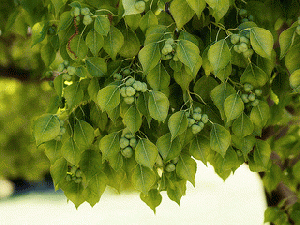| Back OpEd News | |||||||
|
Original Content at https://www.opednews.com/articles/Farmed-Tallowfuel-as-a-Rea-by-Carl-Bernofsky-Climate_Electricity_Energy_Energy-150821-906.html (Note: You can view every article as one long page if you sign up as an Advocate Member, or higher). |
|||||||
August 21, 2015
Farmed Tallowfuel as a Realistic Alternative to Coal
By Carl Bernofsky
The Chinese tallow tree is destined to become a major source of renewable energy because its energy-producing apparatus is sun-driven, self-replicating and never needs to be repaired. This tree is literally a "power plant" and a clear choice as a replacement for coal, whose finite reserves will ultimately be depleted.
::::::::
The Obama administration's "Clean Power Plan," which is designed to reduce carbon dioxide emissions by 32% of 2005 levels by 2030, poses a substantial challenge to the energy sector, particularly where coal is the primary fuel. Topping the list of alternative, renewable sources of energy are wind and solar.
Depending on one's point of view, solar energy brings to mind either rows of static photovoltaic panels or rows of living photosynthetic plants, each of which reduces carbon emissions: photovoltaic panels because they emit no gas, and photosynthetic plants because the carbon dioxide they release upon combustion is balanced by the carbon dioxide they consume through growth and the biosynthesis of fuel.
Louisiana and much of the South is amenable to both types of solar capture, but its climate and access to water make it particularly well-suited to the cultivation of energy crops. The Chinese tallow tree, because of its robust growth and energy-rich content of its abundant seeds is a prime contender. While condemned by some because it can be invasive when not properly contained, this tree is an ideal choice as an alternative, renewable source of fuel for the production of electricity.
Unlike manufactured panels, the energy-producing apparatus of the Chinese tallow tree is self-replicating and never needs to be repaired. Moreover, employing this alternative, solid fuel source in existing coal-fired plants would greatly extend the useable lifetime of those facilities. Tallowfuel is well-positioned for supplementing and ultimately replacing coal inasmuch as government mandates will be curbing the use of coal for generating electricity, while coal's finite reserves will eventually decline, making the cost of production economically unsustainable.
http://www.youtube.com/watch?v=-R0v7u1k8L4
The above video is a brief primer on the planting and harvesting of orchards based on technology developed for the cultivation and harvesting of olive trees, with examples of mechanical harvesters that could be adapted for use with tallow trees, whose energy-rich seeds could serve as a partial substitute and eventual replacement for coal in power plants that generate electricity.
It is incumbent upon the energy industry to embrace all forms of alternative energy sources. Planning now for mass cultivation of sustainable, renewable energy orchards stocked with Chinese tallow trees will help insure that future generations have ample access to electricity. For more information, see: www.tallowfuel.com.
(Article changed on August 21, 2015 at 12:10)
(Article changed on August 21, 2015 at 12:14)
Authors Website: http://www.tulanelink.com
Authors Bio:
Carl Bernofsky, Ph.D., is a former professor of biochemistry at Tulane University and Mayo Graduate School of Medicine. He is the author or co-author of numerous scientific publications and was the recipient of major awards from national granting agencies. A resident of New Orleans for 30 years, he relocated to Shreveport, Louisiana after Hurricane Katrina struck in August, 2005. For many years, he has been an advocate for judicial ethics reform and is working toward a legislative amendment that would require the recusal of adjunct faculty judges from cases that involve the universities that employ them. More recently, he has been advocating the use of tallowfuel as a renewable alternative to coal for the production of electricity.
